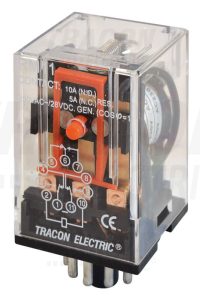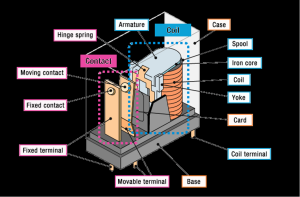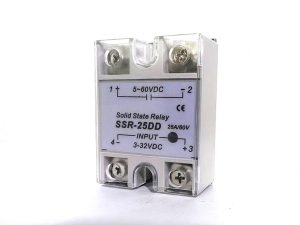
Electromagnetic Relays Basics: Concepts, Types and Advantages
August 24 2023  1703
1703
Inquiry
Global electronic component supplier AMPHEO PTY LTD: Rich inventory for one-stop shopping. Inquire easily, and receive fast, customized solutions and quotes.
QUICK RFQ
ADD TO RFQ LIST
In this blog, we will explore the basics of electromagnetic relays including their concepts, types, and advantages so that readers will foster a deep understanding of them.
What Are Electromagnetic Relays?
Electromagnetic relays are electrical devices that use electromagnets to control the flow of electric current in a circuit. They are commonly used in various applications to switch or control high-power circuits using low-power control signals.
Basic components
Electromagnet: It is the primary component of the relay and consists of a coil of wire wound around a ferromagnetic core. The flow of electric current within the coil results in the creation of a magnetic field. Armature: The armature is a movable component that is attracted to the electromagnet when the coil is energized. It is typically a ferromagnetic material and is mechanically connected to the contacts. Contacts: The contacts are stationary or movable metal pieces that make or break the electrical connection when the relay is operated. There are two types of contacts: normally open (NO) and normally closed (NC). In the resting state, the NO contacts are open, and the NC contacts are closed. Spring: A spring is used to provide a restoring force to the armature when the coil is de-energized. It helps to reset the relay to its initial state when the magnetic field is removed.
Electromagnetic Relay Types
There are various types of electromagnetic relays, each designed for specific applications and operating conditions. Here I present several popular types. Single-Pole Single-Throw (SPST) Relay: This is the simplest type of relay with a single set of contacts. It has one normally open (NO) contact that is either open or closed when the relay is energized. Single-Pole Double-Throw (SPDT) Relay: This relay has one common terminal connected to either of two other terminals. It has one normally open (NO) contact and one normally closed (NC) contact. When the relay is energized, the NO contact closes, and the NC contact opens. Double-Pole Single-Throw (DPST) Relay: This relay consists of two separate SPST relays operated simultaneously by a single coil. It has two sets of contacts, each with a normally open (NO) and a normally closed (NC) contact. Double-Pole Double-Throw (DPDT) Relay: This relay has two separate sets of contacts, each with a common terminal. It provides two normally open (NO) contacts and two normally closed (NC) contacts. When the relay is energized, the contacts change their position simultaneously. Latching Relay: Also known as a bistable relay, this type of relay maintains its state even after the control signal is removed. It has two stable states, set and reset, and requires a pulse of current in one direction to change its state and another pulse in the opposite direction to return to its original state. Reed Relay: Reed relays use a small, sealed glass tube containing two magnetic reeds, which act as the contacts. When a magnetic field is applied, the reeds close, allowing current to flow. Reed relays are compact, have fast switching times, and offer high insulation resistance. Time Delay Relay: These relays incorporate a timing mechanism to introduce a delay between the control signal activation and the switching of contacts. They are used in applications that require time delays, such as motor control, lighting control, or sequencing operations. Solid-State Relay (SSR): Unlike traditional electromagnetic relays, SSRs use semiconductor devices, such as thyristors or triacs, to perform the switching. They have no moving parts, offer faster switching speeds, and high reliability, and are ideal for applications where silent operation and long lifespan are required.
How Do Electromagnetic Relays Works?
The functioning of electromagnetic relays is based on the concept of electromagnetic induction. When an electrical current flows through the coil of a relay, it generates a magnetic field around the coil. This magnetic field then interacts with other components of the relay to control the flow of current in the circuit. So now let’s dive into how they work. Coil energization: A low-power control signal, such as a voltage or current, is applied to the coil of the relay. This control signal energizes the coil and causes an electric current to flow through it. Magnetic field generation: As the current flows through the coil, it creates a magnetic field around the coil. The coil is typically wound around a ferromagnetic core, which enhances the magnetic field's strength. Magnetic attraction: The generated magnetic field attracts the movable component of the relay, known as the armature or plunger. The armature is typically made of a ferromagnetic material that can be magnetized. Contact switching: The movement of the armature is mechanically connected to one or more sets of contacts within the relay. When the armature is attracted by the magnetic field, it moves towards the electromagnet, causing the contacts to change their position.- Normally Open (NO) contacts: In their resting state, the NO contacts are open, meaning there is no electrical connection between them. When the armature is attracted, it closes the NO contacts, allowing current to flow through the relay.
- Normally Closed (NC) contacts: In their resting state, the NC contacts are closed, providing a continuous electrical connection. When the armature is attracted, it opens the NC contacts, breaking the electrical connection.
Electromagnetic Relay VS Solid State Relay
Electromagnetic relays and solid-state relays are two different types of relays that serve similar functions but operate in different ways. Here is a chart about their differences.| Criteria | Electromagnetic Relay | Solid-State Relay |
| Working Principle | Uses an electromagnet to control the switching | Relies on semiconductor devices for switching |
| Moving Parts | Yes | No |
| Switching Speed | Slower | Faster |
| Noise | Mechanical switching noise | Silent operation |
| Contact Wear | Yes | No |
| Lifespan | Limited | Longer |
| Shock and Vibration Resistance | Moderate | High |
| Temperature Resistance | Moderate | High |
| Voltage and Current Handling | High | Moderate to High |
| Suitable for AC and DC Loads | Yes | Yes |
| Applications | Motor control, industrial automation, power distribution | Control of heaters, motor drives, HVAC systems, photovoltaic systems |
Electromagnetic Relay VS Electromechanical Relay
Electromagnetic relays and electromechanical relays are the same thing and the terms are used interchangeably. These relays use an electromagnet to control contact switching. Consider the following key points when comparing electromagnetic relays with other types of relays: Working Principle: Electromagnetic relays operate based on the principle of electromagnetic induction. When an electric current flows through the coil, it generates a magnetic field, which attracts or repels a movable armature. This movement of the armature causes the contacts to open or close, allowing or interrupting the flow of current in the load circuit. Construction: Electromagnetic relays consist of several components, including a coil, armature, spring, and contacts. The coil is wound around a core and generates the magnetic field when energized. The armature is typically a movable iron or steel component that is attracted or repelled by the magnetic field. The contacts are typically made of conductive materials and are connected to the load circuit. Advantages- Good electrical isolation between the control circuit and the load circuit.
- Capable of handling high currents and voltages.
- Can switch both AC and DC loads.
- Suitable for applications with varying voltage levels or inrush currents.
- Motor control and protection.
- Industrial automation and process control.
- Power distribution and switching in electrical systems.
The Advantages of Electromagnetic Relay
Electromagnetic relays offer several advantages that make them a popular choice in various applications. Here are some key advantages of electromagnetic relays: Electrical Isolation: One significant advantage of electromagnetic relays is the electrical isolation they provide. The control circuit, which energizes the coil, is completely isolated from the load circuit connected to the contacts. This isolation helps protect sensitive control circuitry from voltage spikes, surges, or other electrical disturbances in the load circuit. Versatility: Electromagnetic relays are versatile and can handle a wide range of voltages, currents, and power levels. They can be used in both AC and DC circuits, making them suitable for various applications. Additionally, electromagnetic relays can switch both low-power and high-power loads, making them adaptable to different power requirements. Reliability: Electromagnetic relays are known for their reliability. They have a long operating life and can withstand high temperatures, vibrations, and other harsh environmental conditions. This reliability makes them suitable for demanding industrial applications where durability is crucial. Easy Control: Electromagnetic relays are easy to control. When the coil is energized, the relay switches its contacts, either opening or closing the circuit. This simplicity of control makes them compatible with a wide range of control systems, including microcontrollers, PLCs (Programmable Logic Controllers), and other electronic devices. Cost-Effective: Electromagnetic relays are generally more cost-effective compared to solid-state relays or other switching devices. They are widely available, and their simplicity in design and operation contributes to their affordability. This cost-effectiveness makes them a preferred choice, especially in applications where budget constraints are a consideration. Compatibility with Different Loads: Electromagnetic relays can handle various types of loads, including resistive, inductive, and capacitive loads. Whether it's controlling lights, motors, solenoids, or other devices, electromagnetic relays can effectively handle the switching requirements. This versatility makes them suitable for a wide range of applications. Fail-Safe Operation: In the event of a power loss or failure, electromagnetic relays typically return to their default state. For example, a normally closed (NC) relay will automatically close its contacts when power is lost. This fail-safe operation ensures that critical systems or safety functions can be maintained even in unforeseen circumstances. These advantages make electromagnetic relays a reliable and versatile choice for various applications, from industrial control systems to automotive electronics and beyond. However, it's important to consider the specific requirements of your application and consult with an expert to determine the most suitable relay type for your needs.Populer Posts
EP4SGX290FH29I4
Intel
5SGXEA7N2F40C3G
Intel
5SGXMA9N2F45C2LG
Intel
LFD2NX-17-7MG121C
Lattice Semiconductor Corporation
LCMXO2-2000HC-6TG100C
Lattice Semiconductor Corporation
5SGSMD4K2F40C3G
Intel
EP4CE75F29I8L
Intel
EP4SGX230KF40C3N
Intel
10M08DAF256I7G
Intel
AT40K10LV-3AJI
Microchip Technology
